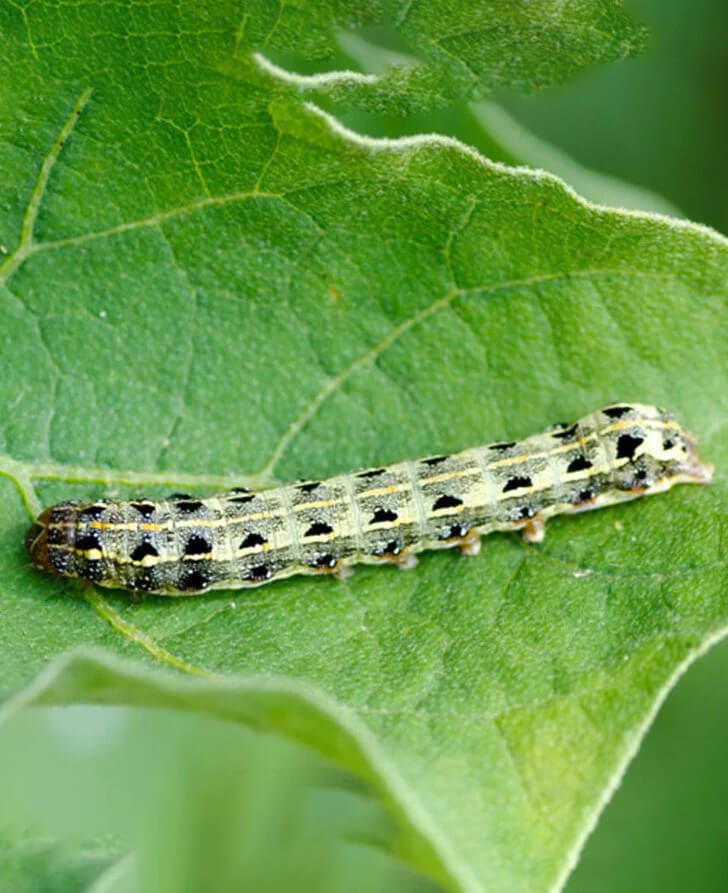Cutworm Overview
Coming from the Noctuidae family, many species of cutworm are common in greenhouses and garden beds in the United States and Canada. Their host plants include corn, tobacco, broccoli, beets, cotton, cauliflower and also different kinds of weeds. They feed by chewing the plant stem just above the ground and eventually cut them – exactly what their name means. Cutworms live 2 inches above the soil and are most active at night.
GET A QUOTE NOWAppearance
Cutworm is a larva of a huge number of moth species. They have a soft body, greyish or dark brown in color and measure 1-2 inches long. Similar to grubs, this pest also curled up when disturbed. They eat at night and bury themselves in the soil during the day. Some species also appear pink, green and black with spots or stripes as well.
Adult cutworms are moths with 1 1/2 inch body length and 1 1/2 inch wing length. They are usually grey or black ragged smudged stripes on their wings. Moths do not cause injury to plants but are responsible for starting the life cycle of cutworms.
Life Cycle
The life cycle of a cutworm begins when the adult moth lays the eggs on grass or another green plant like weeds in the fall. When larvae hatch, they spend the winter deep in the soil or under decaying leaves in the garden. As the temperature gets warmer in the spring, larvae get hungry and will start feeding on the host plant at night and stay unseen during the day. They will go through several molting before becoming pupae. After approximately a week, moths emerge and the cycle starts again. The first generation of cutworms during the spring is the most destructive. Depending on the species, 1-5 generations may occur yearly.
Main Service Areas For Cutworm Treatments
-
 Boca Raton Cutworm Control
Boca Raton Cutworm Control
-
 Boynton Beach Cutworm Control
Boynton Beach Cutworm Control
-
 Lake Park Cutworm Control
Lake Park Cutworm Control
-
 Lake Worth Cutworm Control
Lake Worth Cutworm Control
-
 Palm Beach Gardens Cutworm Control
Palm Beach Gardens Cutworm Control
-
 Palm Beach Cutworm Control
Palm Beach Cutworm Control
-
 Palm Springs Cutworm Control
Palm Springs Cutworm Control
-
 Riviera Beach Cutworm Control
Riviera Beach Cutworm Control
-
 South Bay Cutworm Control
South Bay Cutworm Control
-
 South Palm Beach Cutworm Control
South Palm Beach Cutworm Control
-
 West Palm Beach Cutworm Control
West Palm Beach Cutworm Control
-
 West Lake Cutworm Control
West Lake Cutworm Control
-
 Coral Springs Cutworm Control
Coral Springs Cutworm Control
-
 Fort Lauderdale Cutworm Control
Fort Lauderdale Cutworm Control
-
 Pompano Beach Cutworm Control
Pompano Beach Cutworm Control
-
 Coconut Creek Cutworm Control
Coconut Creek Cutworm Control

Cutworm Damage
Young plants are likely to be attacked by cutworms. They begin chewing the seedling stems near the surface of the soil and will even cut and destroy the plant. Many times, an entire row of newly planted vegetable crops will be cut off over the night but may depend on how severe the infestation is. Once the bottom part of the plant is damaged, the top will die in the long run. Similar to their cousin armyworms, cutworms are also capable of damaging the turf of an entire golf course field, leaving large brown patches.
Ways to Control
Here are a few ideas to control the number of cutworms in your house garden: • Tilting the soil in spring and fall to reveal the pests • Placing toothpick near the plant stem so the cutworm will not be able to attach itself on the stem to feed • Hand-picking the worms wearing gloves at night and dropping them in a bucket of soapy water • Apply natural pesticide • Call your local pest control professional for advice
Licensed, Trusted Pest Control Services
At Fleming Lawn and Pest Services, we protect your home or business with superior care. Unlike the “Big Pest Control companies” we don’t pay our technicians based on how many locations they treat in a day.